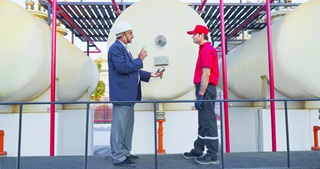Liquified Petroleum Gas (LPG) is one of these combustible gases and should be taken care of with due consideration to guarantee the security of plant and faculty. Industry experts ought to accordingly increase a level of experience with the fundamental ideas of risky territory assurance to have the option to more likely location the difficulties the protected treatment of this gas presents.
What are the Normal Wellsprings of LPG that can Affect the Safety?
Fire temperatures range between 1000 C to 2000 C and are the most intense state to cause any kind of flares in the industrial process.
Sparkles are created during the typical activity of numerous electrical hardware, for example, press catches, contractors, and so forth that can flexibly enough energy to the encompassing unstable climate to bring the gases up in the quick region to their start temperature, which would then be able to cause a self-spreading fire through the entire volume of the gas/air combination.
Electrical hardware additionally can heat up surfaces and reach during ordinary activity or unusual activity. At the point when these temperatures surpass the start temperatures of the encompassing combustible gases, a blast can happen. Other electrical segments of the framework can likewise become expected wellsprings of any mishap in case of protections not taken care, for example in transformers, impedance curls, solenoids and in the fundamental wiring framework.
What are the Safety Tips to Handle LPG usage in Industry?
Liquefied Petroleum Gas (LPG) is fundamentally a combination of butane, business propane or a combination of both and is provided in pressurized chambers.
Safe Keeping LPG Chambers
LPG chambers should be set apart with configuration weights, and temperatures and other data as indicated under significant norms and clients must guarantee that they have all vital data to work the LPG chambers, frameworks and so on securely.
LPG chambers in mechanical establishments ought to be at ground level, with the capacity territory ought to be promptly available to permit brief evacuation of chambers in the event of a crisis. Capacity zones ought to ideally be situated in the outdoors and fenced off by methods for a defensive fence in any event 2 meters high. Such extra rooms ought to have exits through entryways that open outwards and that are not self-locking.
The chambers ought to have a course of action that can give cover against any boundaries of climatic change. The capacity zone floor ought to be cleared or compacted level, with appropriate hard representing the conveyance and dispatch of chambers. The capacity region ought to be found away from any combustible material, and it ought to be freed from all weeds, garbage and so on.
This ought to likewise be away from channels or basements and ought to have a lasting notification, noticeably shown, bringing up the perilous idea of the put-away material. Further, the region ought to likewise have seen restricting smoking and stripped lights.
The danger of unintentional spillage of gas can be limited and thus the significant peril fire by taking care of, stacking and emptying rehearse. Spilling valves can be a wellspring of threat, while a base ring rusty should be changed immediately.
During transportation, chambers, full or void ought to be in upstanding situation, with valves at the top and legitimate methods ought to be received to forestall development. Chambers ought to have appropriate ventilation, and an open vehicle should be utilized where conceivable. Fire extinguishers gear should be prepared nearby, and the vehicle driver ought to be prepared in issues, for example, crisis systems.
For more information visit Safety Tips for Industry or call 91211 77930 to speak with our experts.

 }
}
 }
}
 }
}
 }
}